Physical Address
304 North Cardinal St.
Dorchester Center, MA 02124
Physical Address
304 North Cardinal St.
Dorchester Center, MA 02124
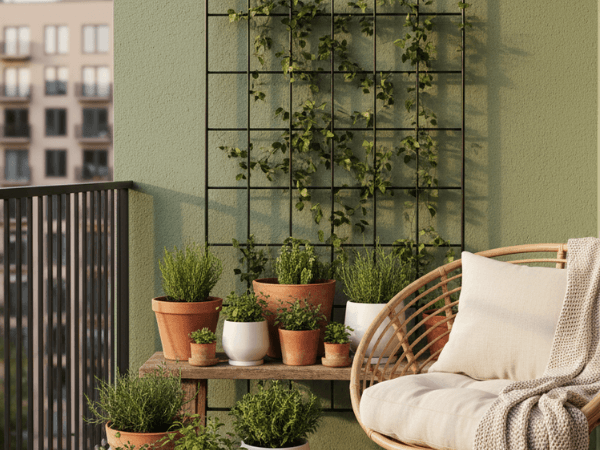
When it comes to creating a beautiful home garden, size truly doesn’t matter as much as style, creativity, and thoughtful planning. Whether you have a compact urban balcony, a narrow patio, or a small corner in your backyard, there’s still plenty of potential to turn that space into a lush, cozy oasis. The surge in popularity of small garden design is largely fueled by the rise of apartment living and the growing desire to reconnect with nature—even in tight quarters. Platforms like Pinterest are overflowing with visually stunning, small-space garden ideas that combine aesthetic appeal with practical functionality. But scrolling through hundreds of pins can be overwhelming. That’s where this guide comes in.
In this blog post, I’ve curated ten chic and clever home garden ideas that are not only Pinterest-worthy but also completely doable in small spaces. From space-saving solutions like vertical gardening to trendy additions like self-watering pots and string lights, these ideas are perfect whether you’re just starting out or looking to refresh your outdoor nook. I’ve also included links to must-have gardening products—like vertical garden trellises and railing planters—that I personally love and recommend from Amazon, so you can easily bring your vision to life without running from store to store.
So grab your favorite beverage, get cozy, and let’s explore how you can transform even the tiniest outdoor space into a lush and stylish sanctuary.
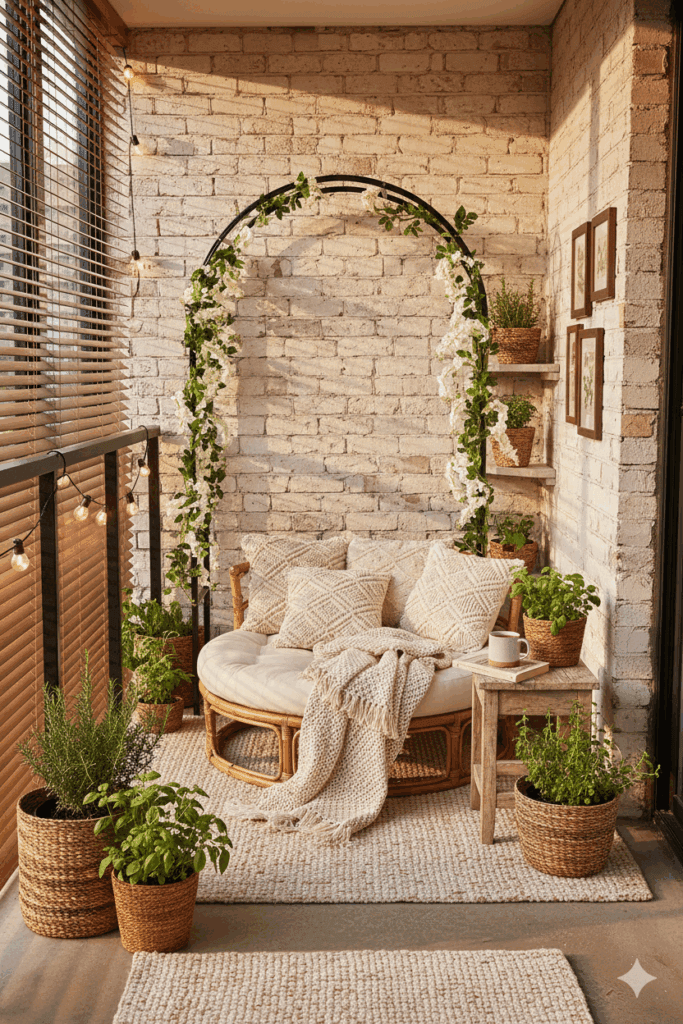
One of the most transformative things you can do in a small garden is to start thinking vertically. When your square footage is limited, your walls, railings, and fences become your greatest assets. Vertical gardening isn’t just a practical technique for maximizing space—it also adds instant visual interest to a garden by drawing the eye upward. Whether you’re working with a petite balcony, a narrow alleyway, or a compact patio, using a vertical garden trellis can help you create a lush green wall without sacrificing precious floor space.
There’s a wide range of vertical garden setups to choose from. If you prefer a clean, modern look, go for a minimalist metal trellis and use it to support climbing vines like jasmine, morning glory, or sweet peas. Want a more rustic vibe? Wooden trellises offer a cozy cottagecore feel and pair beautifully with flowering plants like clematis or even trailing strawberries. For a more modular and flexible approach, consider stackable vertical garden planters that allow you to grow herbs, lettuce, or succulents in tiers. Some options even come with self-watering systems, which means less maintenance and healthier plants.
I personally love using a vertical garden trellis on my balcony wall—not only does it serve as a green backdrop for my reading nook, but it also creates a sense of privacy from neighboring apartments. It’s amazing how much life and color can be added by simply training a few climbing plants along a decorative frame. Plus, this is an excellent way to keep your garden pet-friendly or child-safe, as you can raise toxic or delicate plants out of reach.
🌿 Product Pick: This bestselling vertical garden trellis on Amazon is durable, easy to install, and blends effortlessly into any style of décor. It’s ideal for renters too, as it can be mounted with removable hooks or zip ties.
And here’s the real bonus: a vertical setup is ideal for anyone wanting to dip their toes into vertical gardening without making a huge investment or committing to permanent landscaping. With just a few plants, some creativity, and the right trellis, you can create a lush vertical haven that makes your small garden feel like a vibrant, living work of art.
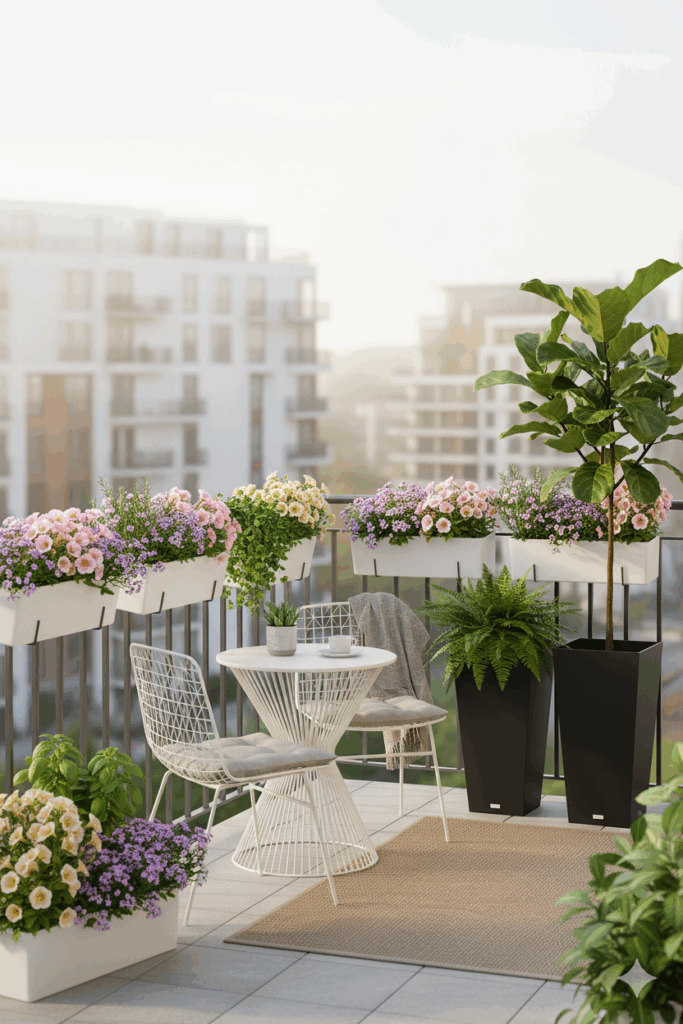
When space is at a premium, every surface counts—and that includes your railings. Whether you’re working with a tiny apartment balcony, a front porch, or a backyard deck, railing planters offer one of the easiest and most effective ways to green up your space without sacrificing room to move. These clever containers hang directly on your railings, bringing lush plants to eye level and transforming even the most ordinary balcony into a garden escape.
The beauty of railing planters is their versatility. They can be used for cascading flowers, fragrant herbs, or even trailing vines. Imagine sipping your morning coffee while the scent of lavender or thyme drifts from the herb-filled planters lining your balcony railing. Or picture cheerful petunias and geraniums tumbling from their containers, adding a burst of color to your view. You don’t need a big yard to enjoy the simple pleasure of tending to plants—just a sturdy railing and a few well-placed planters.
From a design perspective, railing planters also help define the edges of your garden area and create a sense of enclosure. This is especially valuable on open balconies or terraces, where you want to establish a cozy, private atmosphere without blocking the light or views. And if you coordinate your railing planters with your other garden décor—say, matching them with your patio furniture cushions or your vertical garden trellis—you can create a cohesive, polished look that feels intentional and inviting.
Another bonus? Railing planters are ideal for renters or anyone who wants a low-commitment gardening solution. Most models require no drilling or permanent installation and can be removed or repositioned at any time. Look for adjustable brackets or universal-fit designs to ensure compatibility with your railing type, whether it’s metal, wood, or glass.
🌿 Product Pick: These modern railing planters on Amazon are not only weather-resistant but also come in a range of colors to suit any garden aesthetic. I especially love the matte black version for a sleek, contemporary vibe, but there are also terracotta and sage green options if you’re going for a more natural or earthy look.
The key to success with railing planters is choosing the right plants for your light conditions. For sunny balconies, go with heat-tolerant blooms like marigolds, zinnias, or trailing portulaca. For shadier spots, consider impatiens, ferns, or sweet potato vines. And don’t be afraid to mix it up—try pairing flowering plants with trailing greens for extra texture and visual appeal.
With minimal effort and investment, railing planters allow you to add life, color, and charm to your small garden space in a way that feels effortless and instantly rewarding. They’re proof that with a little creativity, you can grow big style in the smallest of spaces.
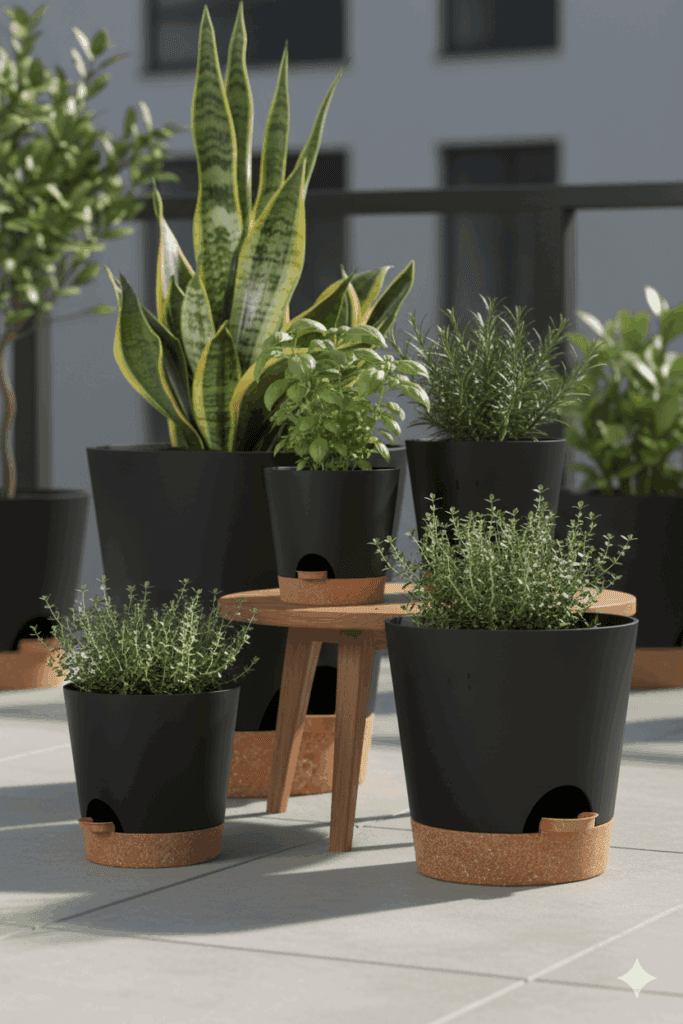
One of the most common struggles people face when trying to maintain a home garden—especially in smaller spaces—is keeping plants properly watered. Life gets busy, the weather changes suddenly, or you simply forget, and suddenly your once-thriving plants start to wilt. That’s where self-watering pots come in. These smart containers are a total game-changer for small garden design, especially if you’re balancing a busy schedule or just starting out with your green thumb.
Self-watering pots work by using a simple water reservoir system that allows plants to absorb moisture as needed through capillary action. This keeps the soil consistently hydrated without the risk of overwatering or underwatering—two of the most common causes of plant stress. For balcony garden setups, where drainage can be tricky and water spills can be messy, self-watering containers offer a clean and efficient solution. You won’t have to worry about staining your patio tiles or over-saturating your railing planters.
But convenience doesn’t mean compromising on style. Today’s self-watering pots come in a wide variety of chic designs, from sleek, matte-finish cylinders that fit perfectly in modern minimalist spaces to rattan-look containers that give your garden a warm, organic feel. Whether you’re planting herbs, succulents, or small flowers, you’ll find self-watering options that blend seamlessly into your overall aesthetic.
What I love most about using self-watering pots in small spaces is how they allow you to focus more on the creative side of gardening—playing with color palettes, textures, and plant pairings—without constantly stressing about daily maintenance. They also give you more flexibility when it comes to placement. Want to put a few pots in that sunny window nook inside or on a high balcony shelf? No problem. As long as you top up the reservoir occasionally, your plants will stay happy and hydrated.
🌿 Product Pick: These self-watering pots from Amazon are a personal favorite. They come in sets, which is perfect for creating a coordinated look across your space, and they include a water level indicator so you always know when it’s time to refill. Some even feature wheels for easy repositioning—a huge bonus if you like to rearrange your layout based on the seasons or your mood.
Self-watering containers also pair beautifully with vertical garden setups or patio planters. You can nestle them into plant stands, hang them on wall hooks, or group them together for an eye-catching cluster of greenery. I often mix a few self-watering pots with standard ones just for the look, but I find myself gravitating toward the low-maintenance options every time when it comes to actual care.
If you’re someone who loves the idea of a flourishing garden but doesn’t want to commit to daily watering or dealing with inconsistent weather, these pots are a small investment that pays off big. They make gardening more accessible, less stressful, and a lot more enjoyable—especially when you’re working within the limits of a small space.
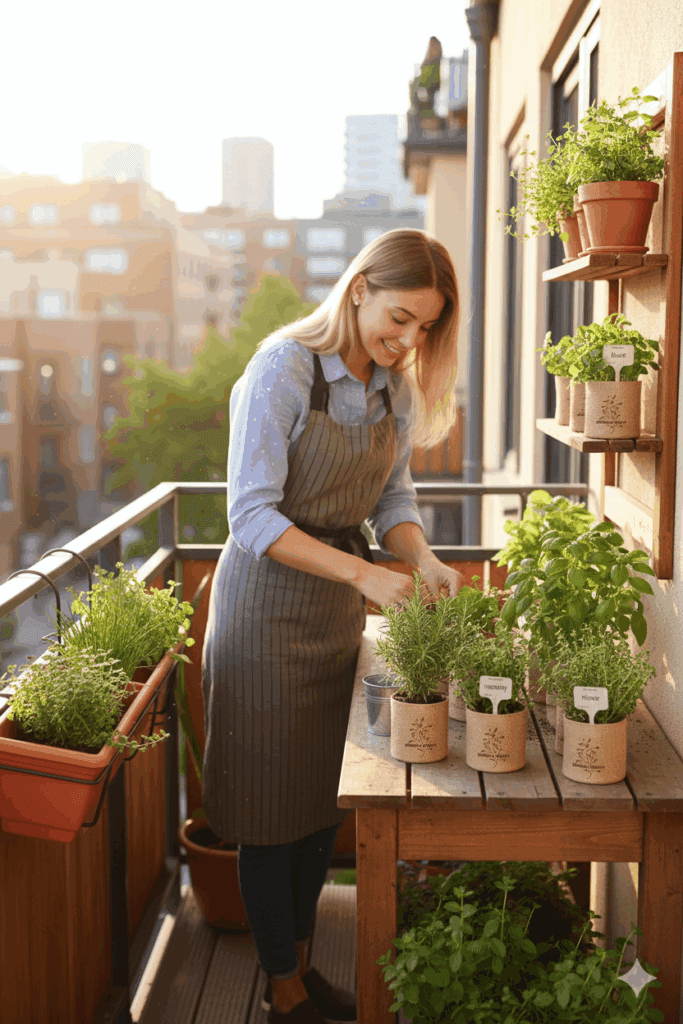
There’s something undeniably rewarding about snipping a few fresh herbs from your own balcony garden and tossing them straight into your cooking. It’s the kind of everyday luxury that feels both practical and Pinterest-perfect. Even if you’re working with just a few square feet, a balcony herb garden is one of the most satisfying small garden design projects you can start—and it’s incredibly easy to maintain.
Herbs are ideal for small spaces because they don’t require deep soil, they grow relatively quickly, and many varieties thrive in containers. Plus, they love being close to the kitchen, whether you have a traditional backyard patio or just a sunny apartment balcony. Think basil, rosemary, mint, parsley, thyme, and chives—all fragrant, compact, and endlessly useful. If you love to cook, even a few of these can completely elevate your meals. And if you’re more into herbal teas or natural skincare, you’ll love having fresh chamomile, lemon balm, or lavender just steps away.
Creating your own herb garden is also a fun way to personalize your space. You can go rustic with terracotta pots and wooden crates, or modern with sleek railing planters and minimalist self-watering containers. For vertical gardening fans, there are tiered stands and hanging wall systems that let you grow herbs in layers, leaving your floor space clear for a small table and chair—or even more plants.
One of the best ways to start is with a herb planter kit, especially if you’re new to gardening or want an all-in-one solution. These kits typically include seeds (or seedlings), labeled pots, soil discs, and sometimes even mini snips or plant markers. They make excellent gifts too, so if you’re ever stuck for an idea for a housewarming present or birthday gift, this is one of those universally loved options.
🌿 Product Pick: This top-rated herb planter kit on Amazon comes with everything you need to start growing a countertop or balcony herb garden. It’s compact, beginner-friendly, and styled to suit almost any home décor. I personally love the farmhouse-inspired wood box sets—they look beautiful on an outdoor shelf or windowsill and keep everything tidy.
To get the most out of your balcony herb garden, pay attention to sun exposure. Most herbs love at least 6 hours of direct sunlight per day, so choose a spot that gets good light. If you’re working with a shady balcony, try herbs like mint and parsley, which tolerate partial sun. Rotate your pots occasionally to encourage even growth, and don’t be afraid to snip often—frequent harvesting actually encourages many herbs to grow back fuller and bushier.
Beyond their culinary uses, herbs can also serve as natural air fresheners and pollinator attractors. Plus, the visual appeal of a thriving herb garden is undeniable. A few green pots of basil and thyme can instantly make your outdoor space feel more alive, more personal, and more purposeful.
A balcony herb garden is the ultimate small-space win: it’s low-maintenance, high-impact, and endlessly customizable. And once you experience the joy of walking outside and picking your own ingredients, you’ll wonder why you didn’t start sooner.
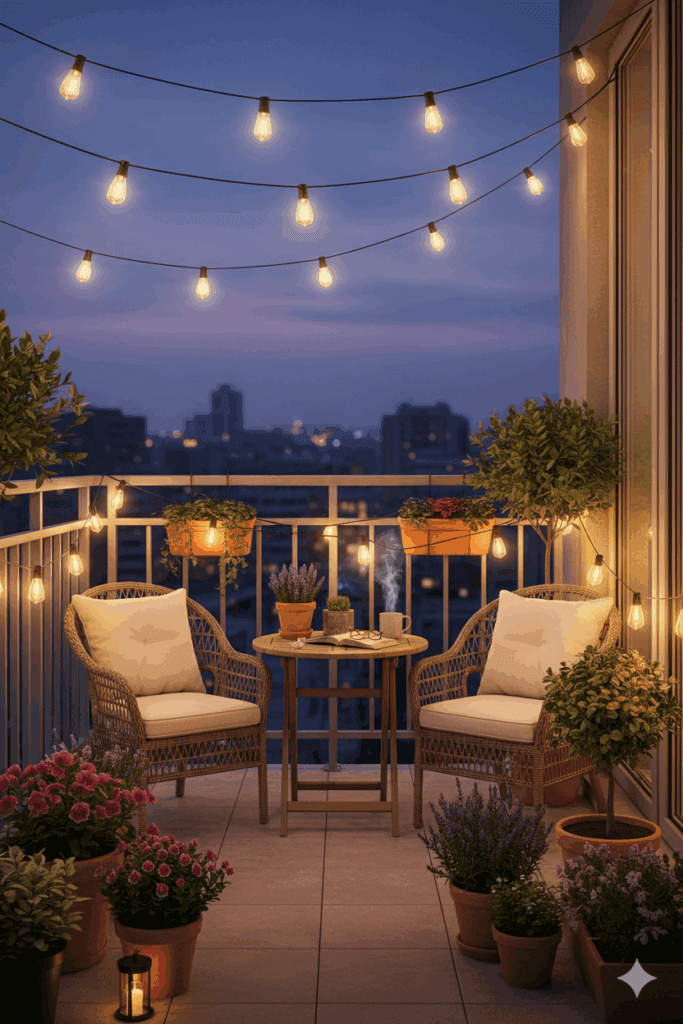
No chic home garden—especially in a small space—is truly complete without lighting that sets the mood. Whether you’re hosting an intimate evening on the balcony or enjoying a quiet solo dinner on the patio, outdoor string lights can completely transform your environment. With just a few strands, you can elevate your tiny garden into a magical escape that feels cozy, inviting, and endlessly Instagrammable.
String lights aren’t just for aesthetics—they also serve a practical purpose by extending the usability of your outdoor space into the evening hours. And in smaller areas, lighting plays an even more important role. Since you’re working with limited space, your design choices have to do double duty. A well-placed set of soft-glow LED lights creates ambiance, adds warmth, and highlights key features like your vertical garden or herb planter setup—all without taking up a single square inch of floor space.
There are several ways to incorporate string lights depending on your layout. On a balcony, wrap them along the railing or drape them overhead from wall hooks or a nearby roof edge. For patios, you can zigzag them above your seating area, or string them between poles or tall planters. Even a small set hung behind your plants can create an enchanting backlight effect that turns your green corner into an atmospheric retreat.
If you’re looking for low-maintenance options, solar-powered outdoor string lights are a fantastic choice. They automatically charge during the day and light up at night—no need to worry about switches or extension cords. For renters, battery-operated versions or USB-rechargeable models can be easily installed and removed without any drilling or wiring.
🌿 Product Pick: These best-selling outdoor string lights on Amazon are weatherproof, energy-efficient, and come in both warm and cool tones. I particularly love the vintage Edison bulb style—they add a café-like charm that’s perfect for evening relaxation or entertaining. They’re also long enough to span most small spaces with a single strand.
Another smart design move? Pair your lights with a few reflective surfaces. A mirror tucked into a corner, a glass-topped table, or even metallic planters can bounce the light around and make your small garden feel larger than it actually is. This is especially effective in urban balcony gardens where natural light is limited after sunset.
Lighting is also one of the easiest ways to create a consistent theme. Want a Boho feel? Go for warm amber bulbs and pair them with macramé hangers and patterned cushions. Prefer something modern and sleek? Choose cool white LEDs and match them with minimal furniture and dark planters. The options are endless—and the impact is immediate.
So, whether you’re winding down with a book, sipping wine with a friend, or just admiring your latest blooms, outdoor string lights add that magical glow that turns any small garden into a truly special place. It’s the final touch that ties everything together—and once you’ve experienced your garden lit up at night, you’ll never go back.
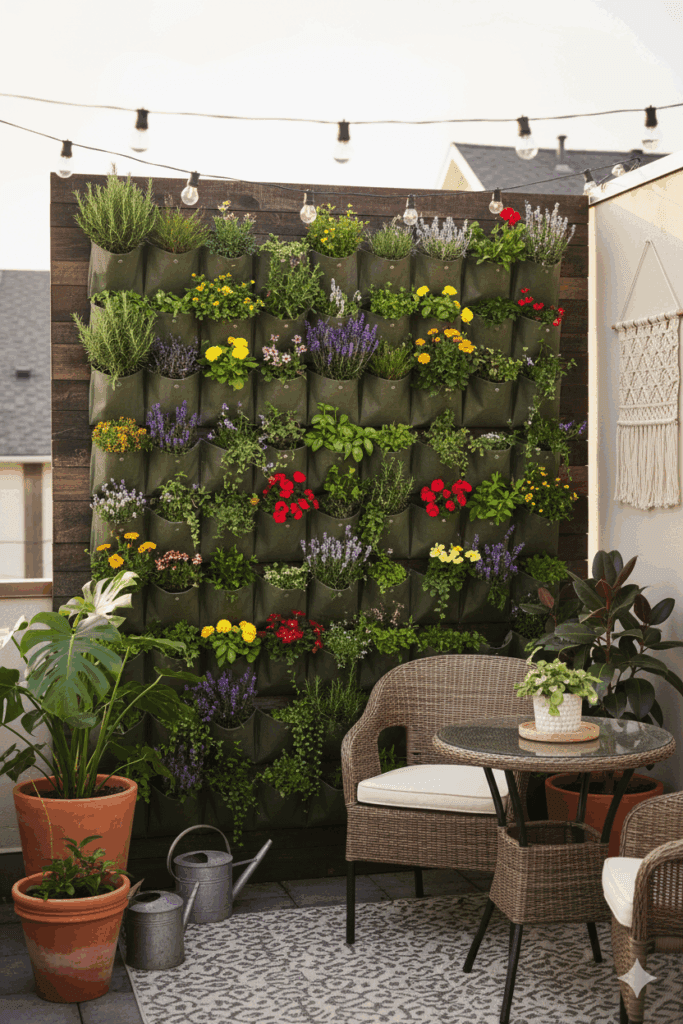
When you’re working with a compact outdoor space, like a balcony, narrow patio, or even a small backyard, it’s essential to get creative with every surface—and that includes your walls. A wall garden, also known as a vertical green wall, is one of the most stylish and space-efficient ways to bring abundant plant life into a small garden design. It instantly adds depth, texture, and lush greenery without eating into your valuable floor space, making it a perfect choice for apartment dwellers or anyone with limited square footage.
There are many ways to build a wall garden depending on your budget, style, and level of commitment. You can go the DIY route by mounting wooden crates or repurposed shelves, or you can opt for a modular vertical planter system designed specifically for this purpose. Felt pocket planters, for example, are lightweight and easy to install, offering individual pouches for herbs, succulents, or trailing flowers. These systems are especially great for renters, as they can be hung using over-the-door hooks or mounted on removable racks, avoiding the need for nails or screws.
What makes wall gardens particularly chic is their ability to create visual interest. Instead of a blank, unused wall, you now have a living tapestry—one that changes with the seasons and reflects your personal aesthetic. Want a bold, jungle-like vibe? Use cascading pothos, ferns, and trailing philodendrons. Prefer a more minimalist, structured look? Use symmetrical rows of herbs or succulents in matching containers. You can even mix textures and colors by alternating between green foliage and flowering plants like begonias or petunias.
From a functional standpoint, a wall garden is also a great solution for balcony gardens that lack sunlight on the floor but receive indirect light higher up. Mounting your plants at eye level not only makes them easier to admire and care for, but it also ensures they get better light exposure—especially important for species like basil or rosemary that need at least 6 hours of sun per day.
🌿 Pro Tip: Combine your wall garden with self-watering planters or attach a drip irrigation system if you’re covering a larger area. This saves you time and ensures your vertical garden stays lush and vibrant even during hot summer months.
Another benefit? Wall gardens can act as natural insulation and sound barriers. If you’re living in a noisy urban environment, a thick wall of plants can help soften sound and create a peaceful retreat. They also help regulate temperature on hot balconies by cooling the space through natural evaporation.
You can even use wall gardens indoors if your outdoor area is extremely limited. Mount a few herb planters on your kitchen wall, or create a calming green corner in your living room using wall-mounted ferns and trailing ivy. Many vertical garden setups are designed to be equally beautiful and functional indoors and out.
A wall garden may seem like a design feature you’d only find in luxury apartments or Pinterest-perfect patios, but it’s surprisingly accessible for any home gardener. With just a little planning, a handful of containers, and a few well-chosen plants, you can turn a plain wall into the centerpiece of your small garden—one that’s as functional as it is fabulous.
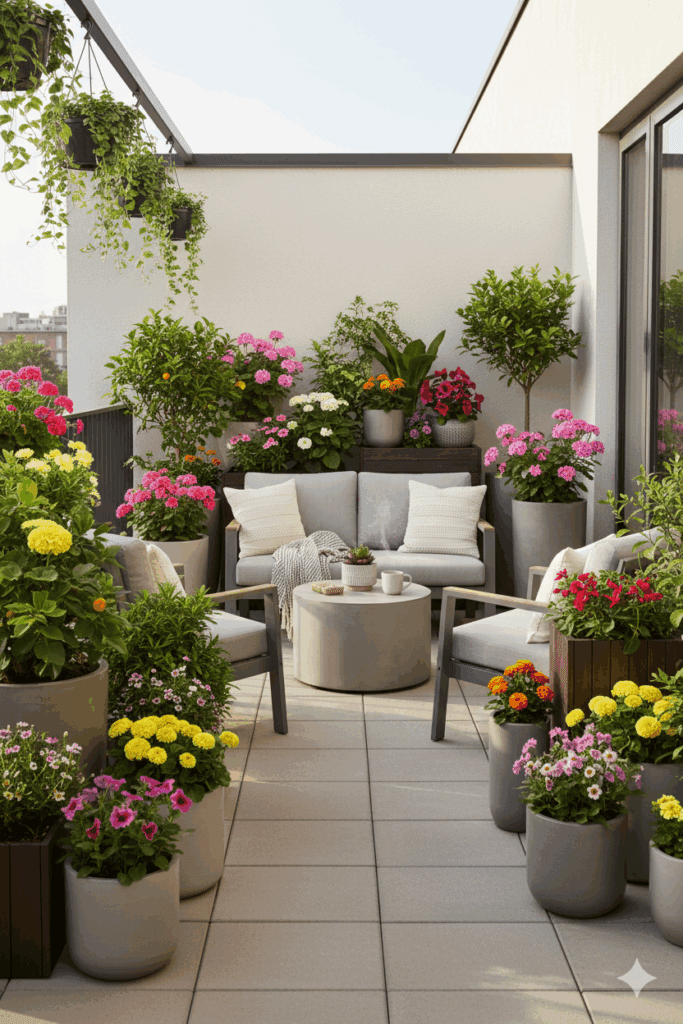
When designing a small garden, choosing the right containers is just as important as choosing the right plants. Oversized or bulky pots can overwhelm a limited space, while tiny mismatched containers can make things look cluttered or chaotic. That’s why compact patio planters are a key element in small garden design. They strike the perfect balance between form and function, offering enough room for roots to grow while maintaining a sleek, space-saving profile that keeps your outdoor area feeling open and inviting.
Patio planters come in a wide range of shapes and materials, which means you can easily match them to your aesthetic—whether that’s modern, rustic, boho, or minimalist. Tall, narrow planters are especially useful in small spaces; they allow you to grow larger plants or small trees like dwarf citrus or bamboo without taking up too much horizontal room. Square or rectangular planters can be lined up along a wall or railing to create structure and rhythm in your garden layout, helping to define zones without the need for bulky furniture or fencing.
For a cohesive and polished look, consider sticking to a neutral color palette or a consistent texture across your containers. Coordinating planters with other elements—like your balcony railing planters or vertical garden trellis—can help the space feel well-designed and intentional, even if it’s just a few square meters.
But compact planters aren’t just about good looks. They also make maintenance easier. With fewer plants in fewer pots, you can streamline your watering, feeding, and pruning routine. This is especially helpful if you’re using self-watering pots inside your patio planters or want to integrate a smart irrigation system later on. And if you’re growing edibles like cherry tomatoes, peppers, or lettuce, compact containers can give you full control over soil quality, pests, and light exposure—all while keeping things neatly contained.
🌿 Product Pick: These space-saving patio planters on Amazon are perfect for small areas. Look for stackable or modular designs that allow you to expand your garden vertically, or opt for planters with built-in trellises for climbing plants like peas or beans. Some even include wheels for easy repositioning as the seasons change or the sun shifts.
One of my favorite tricks for maximizing space is to use plant stands or tiered shelves. Placing a few compact planters at different heights not only gives your small garden a more dynamic, layered look but also improves airflow and light exposure. You can even use a bar cart or side table as a mobile planter station—a stylish way to display your favorite greenery while staying flexible with your layout.
Compact planters also allow for easy seasonal refreshes. In spring, fill them with bright bulbs like tulips or daffodils. In summer, switch to herbs, leafy greens, or annuals. In fall, try ornamental cabbages, pansies, or small evergreen shrubs. Their manageable size makes it easy to swap plants in and out as the mood—or weather—changes.
So don’t underestimate the power of a good planter. In small garden spaces, they do much more than hold plants—they shape the entire look and feel of your outdoor sanctuary. With smart, compact patio planters, you can maximize your growing potential while keeping your space open, elegant, and full of personality.
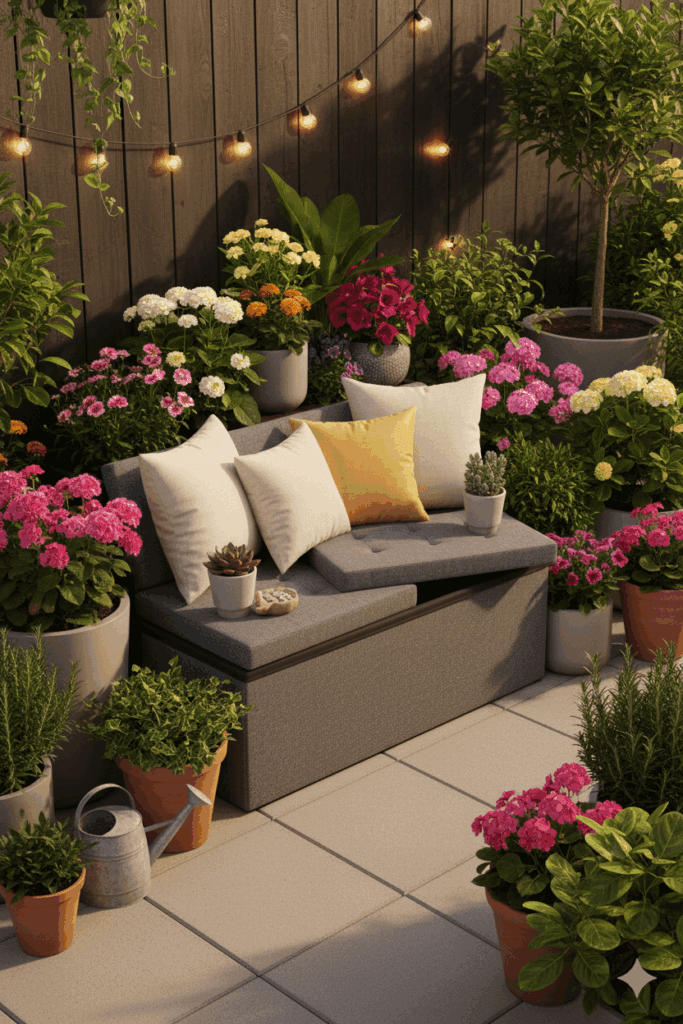
In small gardens, multifunctional furniture is not just a convenience—it’s a necessity. When every inch counts, each item needs to earn its place. That’s why a foldable garden bench with built-in storage is one of the smartest additions you can make to a small balcony, patio, or backyard space. It’s a clever blend of seating and organization, and it instantly upgrades your garden’s comfort level without creating clutter.
Imagine this: a charming little bench nestled between your compact patio planters and your railing planters, offering you a place to relax with a cup of tea or a good book. Now imagine that same bench quietly holding your gardening gloves, extra pots, seed packets, string lights, or outdoor cushions. It’s like a hidden helper that keeps your garden essentials out of sight but within easy reach—and in a small space, that kind of discreet storage is gold.
What makes foldable benches so ideal for small garden design is their flexibility. When not in use, many models can be collapsed and stored flat, making room for entertaining, yoga, or simply giving your plants more breathing room. Others double as tables or potting stations, transforming easily based on your needs and the season. Whether you want to repurpose the space for summer dinners or winter storage, this kind of furniture adapts with your lifestyle.
Stylistically, there are endless options. You can go for rustic wood to match a natural, herb-filled garden, or sleek metal and plastic combinations for a more contemporary vibe. Choose a neutral color like gray or tan to blend seamlessly with your planters and walls, or make it a design focal point by choosing something in a bold color that contrasts with your greenery.
🌿 Product Pick: This foldable garden storage bench on Amazon is one of the best I’ve found—it has a weatherproof finish, soft-close lid, and enough room inside for tools, outdoor blankets, or even a small watering can. Plus, it’s surprisingly lightweight and easy to move if you want to reconfigure your layout.
Another creative use for these benches? Create a cozy corner by placing one along a wall under your vertical garden trellis, layering it with cushions and throws. Add a nearby planter with tall grasses or bamboo for a sense of enclosure and privacy. This transforms your small space into a retreat that feels separate from the rest of the home, even if it’s just steps from your kitchen.
And if you’re someone who likes to entertain, the storage component becomes even more valuable. You can quickly stash items away to tidy up your space for guests, or use the interior to store outdoor-friendly plates, napkins, or citronella candles for impromptu balcony dinners.
Ultimately, a foldable bench with storage isn’t just about saving space—it’s about adding intentional functionality and elevating your experience in your garden. It’s these kinds of small, thoughtful details that make a compact outdoor area not only work but feel like a personal oasis.
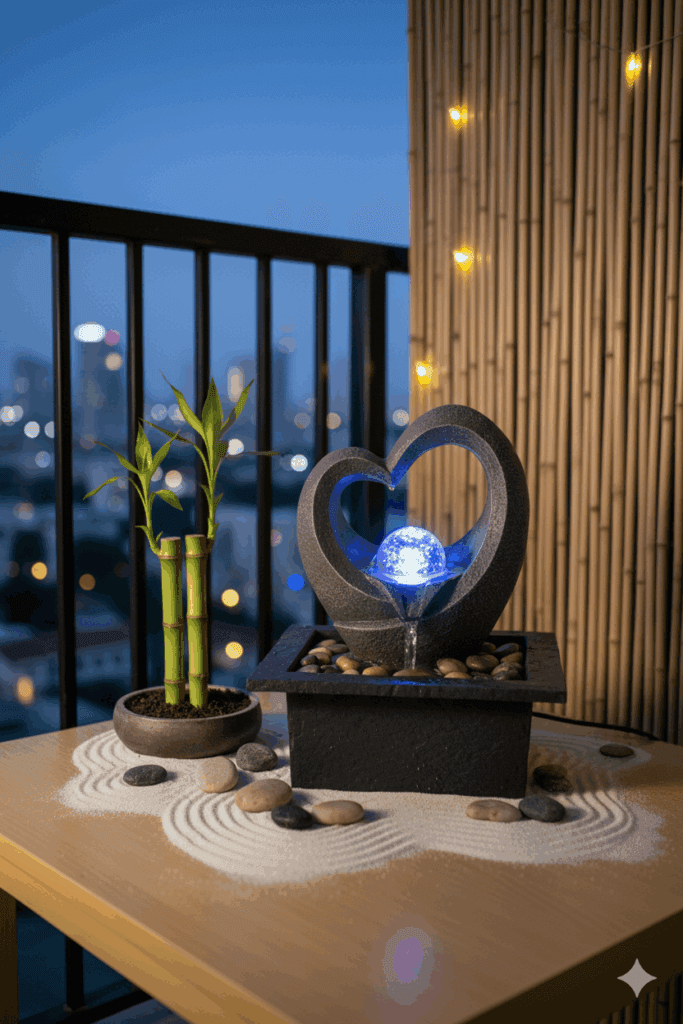
In our fast-paced, always-connected lives, having a peaceful spot to unwind—no matter how small—is more essential than ever. And your garden, even if it’s just a balcony or narrow patio, can absolutely become that sanctuary. One of the most beautiful and restorative ways to do this is by creating a mini Zen corner. Inspired by Japanese garden philosophy, a Zen corner embraces simplicity, natural elements, and mindfulness. It’s not about how much space you have—it’s about how you use it to bring peace and presence into your daily routine.
At its core, a Zen garden celebrates harmony with nature. You don’t need to install a full koi pond or invest in ornate sculptures. In fact, it’s the minimalism that makes this design work so well in small spaces. All you need are a few carefully chosen elements: stones or pebbles to represent the earth, a small water feature (like a tabletop fountain) to add sound and movement, and greenery to bring in life and growth. Add in a meditation cushion or low stool, and you’ve created a calming escape that feels miles away from the everyday chaos—even if you’re just a few feet from your kitchen door.
A mini Zen corner can be tucked into a shaded nook or even take up a central spot in your layout. It works beautifully when surrounded by taller patio planters, bamboo screens, or railing planters filled with ferns and ornamental grasses. You can use smooth river stones to line the ground, stack flat rocks for a natural sculpture, or rake white gravel into meditative patterns if you have a bit of space to spare. These textures not only create visual depth but also bring a tactile richness to your garden experience.
Water plays an important role in Zen design, so consider adding a small solar-powered fountain. The gentle trickling sound helps drown out urban noise and creates a sense of continuity and calm. Pair it with aromatic herbs or calming plants like lavender, sage, or lemongrass, and your space becomes a full sensory retreat—smell, sound, sight, and touch all working together to help you relax.
🌿 Optional Add-on: Add a small wind chime or set of outdoor string lights with a warm glow to enhance the ambiance during evenings. These simple touches transform your Zen corner from a daylight meditation spot into a dreamy nighttime escape.
This type of setup isn’t just for yoga lovers or meditation pros. Even if you never sit cross-legged in the space, simply having a quiet, intentionally designed area in your garden can dramatically affect how the space feels overall. It becomes a visual reminder to slow down, breathe, and connect with nature—something we could all use more of.
You can personalize your Zen corner as much as you like. Add a small bench, a favorite quote engraved on a stone, or even a tea table for slow mornings. The goal is to create a place that feels like yours—a little haven you can return to anytime you need a break from the digital noise or household stress.
In small garden design, where every choice counts, a Zen corner offers something that no amount of color or decor can replace: peace. And that, in the end, is what makes any garden—no matter how big or small—truly valuable.
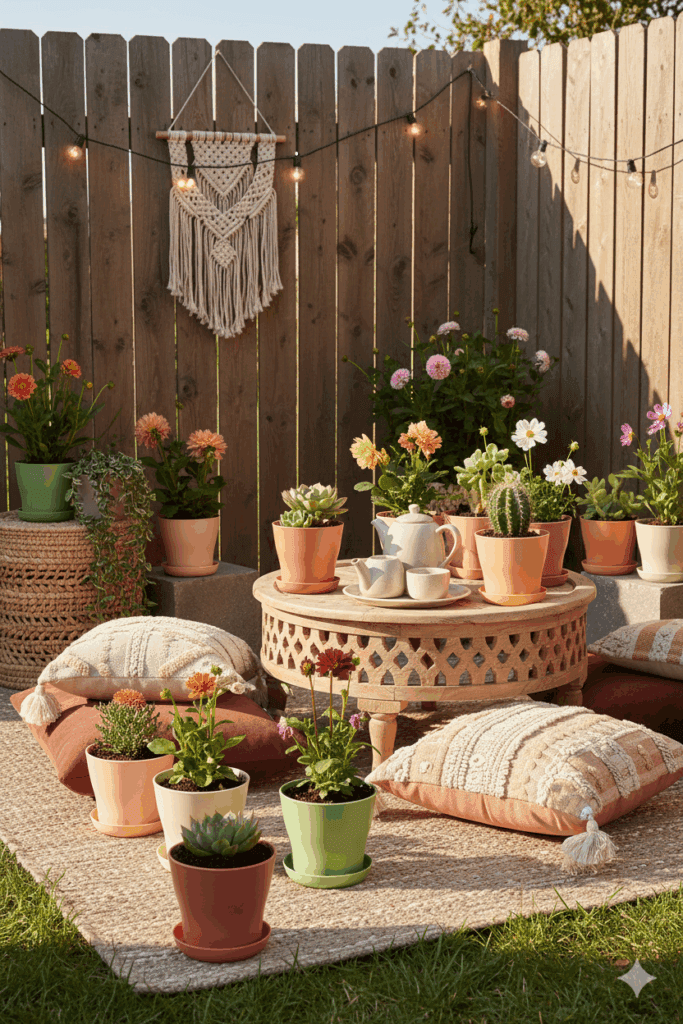
When designing a small garden, one of the most overlooked—but most powerful—ways to elevate the entire space is through color coordination. Just like in interior design, a cohesive color theme brings harmony, balance, and intentionality to your outdoor area. In fact, choosing and sticking to a color-coordinated theme can make a tiny balcony, patio, or courtyard feel much more polished, curated, and even spacious.
Color influences how we experience space. Light tones can open up an area and make it feel airier, while darker shades create a moody, cozy ambiance. Warm palettes—like terracotta, mustard, and rust—evoke Mediterranean vibes and pair beautifully with wood and greenery. Cool tones—like sage, navy, or charcoal—feel modern and calming, especially when combined with sleek metals or minimalist furnishings.
Start by picking a base color palette that works with your surroundings and your personal style. From there, apply it consistently across your planters, cushions, garden tools, accessories, and even your plants. Yes, your plants! You can create color stories with flowering plants in matching or complementary hues—think soft pink roses and pale lavender, or bold orange marigolds and deep red coleus. Even foliage plays a role; mix different shades of green with burgundy, silver, or variegated leaves to add depth without overwhelming the space.
The same rule applies to your containers and furniture. For example, pairing railing planters, compact patio planters, and your vertical garden trellis in the same material or color family (such as matte black metal or rustic clay tones) creates a seamless visual flow. This not only looks more sophisticated but also helps to reduce visual clutter—a key goal in small garden design.
🌿 Design Tip: Use no more than 2–3 core colors in your palette. You can add accent tones through seasonal flowers, textiles, or decorative items like lanterns or garden statues, but keeping your core palette focused will maintain that chic, Pinterest-worthy aesthetic.
One of the easiest ways to tie everything together is by using matching outdoor string lights or coordinated soft furnishings. A set of sage green cushions, paired with light wood planters and warm white string lights, can instantly create a tranquil, spa-like atmosphere. Or go bold with jewel tones—deep teal planters, magenta flowers, and gold accents—for a dramatic boho-chic look.
Color also plays into how you experience the space at different times of day. Soft blues and grays feel cool and crisp in the morning light, while earth tones glow beautifully at golden hour. String lights or lanterns in warm hues can highlight your palette at night, making the space feel intentional and lived-in around the clock.
And here’s where it gets especially fun: once your core palette is established, you can start styling your space just like you would an indoor room. Add a color-matching garden stool, a patterned outdoor rug that complements your flower colors, or even a painted accent wall or privacy screen that anchors the whole look. Your small garden becomes more than a place to grow plants—it becomes an extension of your home, a curated outdoor room that reflects your style and makes you want to spend more time outside.
In the world of Pinterest-style inspiration, visual consistency is everything. A color-coordinated garden theme doesn’t require a big budget or fancy landscaping—it just takes a bit of vision and a few thoughtful choices. But once you put it all together, the effect is stunning. Even a simple balcony can look like it came out of a design magazine.
A beautiful, relaxing home garden doesn’t require a sprawling yard or a professional landscaper. With the right ideas—and a little creativity—you can turn even the smallest balcony, patio, or corner into a lush and stylish oasis. From clever vertical gardening tricks and compact patio planters to functional self-watering pots and cozy outdoor lighting, these 10 chic home garden ideas prove that size is no barrier to beauty.
What truly transforms a small garden into something special is intentionality. Every pot, plant, and accessory plays a role—not just in how your space looks, but in how it feels. Whether you’re starting from scratch or refreshing your current setup, the key is to balance practicality with personality. Your garden should reflect your style, support your lifestyle, and invite you to slow down, breathe deep, and enjoy the little things.
So go ahead—pick one or two ideas from this list and give them a try. You might be surprised by how quickly your tiny outdoor space becomes your favorite place in the world.
Make your dream garden a reality with these space-saving, Pinterest-inspired products:
🪴 Tip: Most of these items are eligible for free shipping and easy returns. Add your favorites to a Pinterest board or wishlist to plan your garden visually before buying.